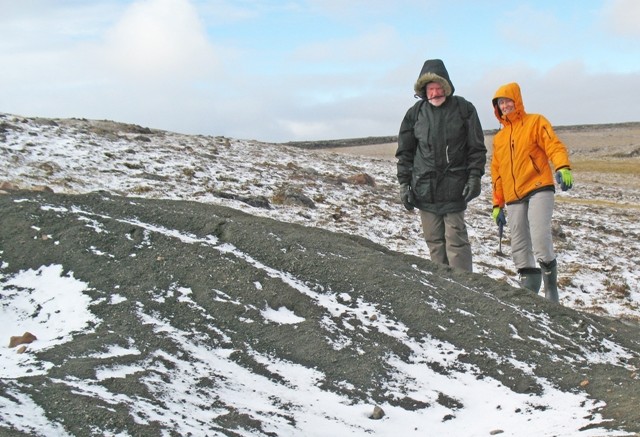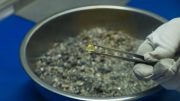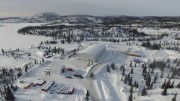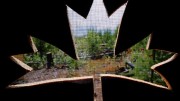He’s been in the business for 56 years. He was integral in developing Canada’s diamond sector. He has been named Prospector of the Year by the Prospectors and Developers Association of Canada, and was inducted into the Canadian Mining Hall of Fame.
Were Gren Thomas to slow down, the mining world would understand. Instead, he just reorganized and refinanced his latest diamond exploration entity, North Arrow Minerals (TSXV: NAR), and is elbow-deep in the fuel shipments, barge bookings, and rail arrangements needed to take a bulk sample from North Arrow’s Qilalugaq project, which is home to a deposit that Thomas thinks will be a “company maker.”
Thomas’ drive stems from the same belief that led him and partners Chris Jennings, Earl Curry, and Robert Gannicott to stake the claims that became the Diavik mine: that the Canadian Shield is prime diamond territory.
“Canada is the third-largest producer in the world and it’s still relatively untapped,” Thomas said in a recent interview. “There’s been a hell of a lot of exploration done over the last ten years, but compared with the length of time that Russia and Botswana have been producing, Canada is still early on in the game.
“There have been a lot of kimberlites discovered here but there is still so much ground left that I think in time, Canada could well end up being the largest producer in the world.”
Years spent in the mining sector, though, mean Thomas is also a realist. While he believes Canada could be the world’s leading diamond producer, Thomas sees another possible path, one where unmanageable regulatory burdens and native land claims conflicts choke out exploration and, within little more than a decade, knell the death toll for Canada’s diamond mines.
Life in mining
Arriving in Canada from Wales in 1964, Thomas’ early career as a mining engineer included time with Falconbridge in Sudbury and at the Giant gold mine near Yellowknife. By the 1970s, he started to focus on exploring for minerals in the north.
In 1975, he founded Highwood Resources, which soon discovered the Thor Lake (Nechalacho) rare metals deposit now under development by Avalon Rare Metals (TSX: AVL; NYSE-MKT: AVL). In 1980, he formed his flagship company, Aber Resources. In 1991, Aber was working on its Sunrise Lakes massive sulphide discoveries when rumours started to swirl about a diamond discovery in the Lac de Gras area.
By moving quickly to tie up prospective ground in the area of Charles Fipke and Stewart Blusson’s diamond find, Thomas, Jennings, Curry, and Gannicott were rewarded.
Aber and Jennings’ company, SouthernEra Resources, had a commanding land position in the midst of the diamond rush. In 1992, Aber drilled its first magnetic anomaly and intersected its first kimberlite. By 1995, a bulk sample from the A-154 kimberlite pipe returned a grade of 4.5 carats per tonne.
Five years later, Aber and project partner Kennecott (Rio Tinto [RIO-N]) made a development decision and by early 2003, the Diavik mine was in operation. One of the world’s richest diamond mines, Diavik produces more than 10 million carats annually and cemented Canada’s importance in the global diamond sector. That role continues, with two more Canadian diamond mines now in operation and several projects that could enter operations within the decade.
However, despite all the exploration that’s taken place in Canada and around the world, there have been no big discoveries since the Lac de Gras finds, Thomas says.
“Anybody who makes a discovery in the next year or two that could be a significant producer is going to enjoy the benefit of better prices, because prices are going to go up because of the lack of discoveries.”
While Thomas believes there is enough work going on in the Lac de Gras area to keep Ekati and Diavik open for many more years, developing new mines in the Canadian north will be much more difficult. Costs are so high that only large discoveries justify development, but to make large discoveries someone has to be exploring. And that’s the problem.
A dearth of capital has slowed grassroots diamonds exploration almost to a halt.
“Right now it’s so difficult to raise money,” Thomas said. “People don’t have money to spend — anyone who is making money is putting it into more secure things — so brokers don’t have access to money. But it is showing signs of getting better. I mean, it got so bad that it can’t get worse, so it has to start getting better.”
However, the markets are only one part of the problem. If and when grassroots exploration returns, Thomas believes the development climate in Canada still makes it difficult to build a mine.
“If they could solve some of those issues, like these land use rights conflicts and all these unsettled land claims, it would make life a lot easier,” Thomas said.
Thomas blames an underlying human trait for much of the conflict between the resource sector and those opposed to mineral development: the law of unintended consequences.
“People make these knee-jerk decisions without thinking about the consequences — you see it every day,” he said. “The law of unintended consequences has not been repealed.”
As an example, Thomas points to the recent Yukon Supreme Court decision affirming a lower court ruling that explorers have to consult with the Ross River Dena before staking mineral claims in the First Nation’s territory.
The Ross River Dena, who have unsettled land claims with the Yukon (and therefore exploration and development processes are not defined) want to ensure they know what is happening on their lands right from the get-go. However, it is impractical — arguably impossible — for exploration companies to consult before even staking ground. Staking comes before basic exploration and therefore before explorers have any concept of the area’s geologic potential.
The rising costs of environmental remediation bonds are another good example.
“The government is making noises about making these reclamation bonds bigger and bigger, but you can only make these things so big or companies won’t be able to afford them,” he said. “If you’re building a mine and you have to put up a bond for $20 million, OK, you can probably afford that. But if it is $200 million, it’s impossible — how can you finance that?
“Again, it comes back to the law of unintended consequences,” Thomas continued. “You didn’t mean to, but you’ve just made that mine uneconomic.”
Despite his concerns, Thomas believes in a positive future for Canadian diamonds.
“I’m optimistic it will change,” he said. “In the long term I think it will be a healthy business.”
North Arrow
It was about a year ago that North Arrow found itself in trouble. Like so many juniors, it had several interesting properties but almost no cash. Luckily, it had Gren Thomas for a chairman.
Thomas stepped up. Taking on the CEO role temporarily (Ken Armstrong took over as president and CEO in April), he led a complete corporate reorganization that included a ten-to-one share rollback, several new board appointments, and crucially, a financing.
Every mining downturn creates opportunities, but only if you have cash. For the few with capital, it’s a buyer’s market and one choc-a-block with interesting properties. North Arrow has been able to take advantage of that market and for that Thomas gives full credit to Lukas Lundin.
“The upside in a downturn is for companies like us that manage to acquire projects that, in a normal market, we couldn’t get in to,” Thomas said. “We were lucky to get access to money through Lukas’ group. . . Lukas and his group are already the largest shareholders in North Arrow and in the financing under way now they’ll again be the biggest participants.”
Lundin’s interest in the company helped Thomas close a $3-million financing in March. That put enough cash in the bank to mobilize a few drills, fly some geophysical surveys, and add several new properties to the portfolio.
“This is the whole point with North Arrow: we have a number of projects now that we could not normally have been involved with,” Thomas said. “With Qilalugaq, for example — Stornoway would be developing that project itself if it could, but it’s stuck. It’s trying to develop its mine in Quebec, it’s having trouble raising money, so it had to farm it out.”
Located less than 10 km from the town of Repulse Bay in Nunavut, Qilalugaq is home to eight kimberlite pipes, including the 12.5-hectare Q1-4 pipe — the largest kimberlite pipe in the eastern Canadian Arctic.
Stornoway Diamond (TSX: SWY) optioned the project from BHP Billiton (NYSE: BHP) in 2006 and earned full ownership in 2010. Two years later, the company announced an inferred resource for Q1-4 of 26.1 million carats in 48.8 million tonnes averaging 53.6 carats per hundred tonnes extending from surface to 205 metres depth.
The estimate also identified additional resource upside at the project of between 7.9 and 9.3 million carats from 14.1 to 16.6 million tonnes of kimberlite beneath the defined resource.
“We know that the tonnage is there and we know what the grade is because there’s been enough drilling done,” Thomas said. “What we don’t know is the value of the stones.”
The value of Qilalugaq’s diamonds is important as the grade of the kimberlite is not very high compared with Diavik and Ekati. However, Qilalugaq seems to offer an unusual advantage: coloured stones, yellow ones in particular.
“There’s a variety of different colours and if they translate into the larger stones, then we could be dealing with quite a high value per carat,” Thomas said. “From all we know and from all the people who have looked at the stones and at the deposit, we’re optimistic that we should be able to find larger stones of those colours.”
To assess the value of the diamonds, North Arrow plans to take a mini-bulk sample next summer. The deposit starts at surface, so 1,500 tonnes of material can be extracted in a few days with a small digger. The hard part will be moving 1,500 one-tonne bags of rock from the project to Thunder Bay, Ont., where it can be processed.
That process will involve a helicopter, a barge, and a train. The details are still unclear but the groundwork is already being laid, with North Arrow having stockpiled fuel at Qilalugaq so work can get under way before the sea ice melts in July. The company has also arranged funding for the effort: at presstime, the company had just completed a $5.5-million private placement of common shares priced at 40¢ each.
Completing the mini-bulk sample will also give North Arrow 80% ownership in Qilalugaq, pursuant to the earn-in deal it signed with Stornoway in April. Thomas is very keen to get the job done and solidify North Arrow’s stake in what he sees as an important and advanced Canadian diamond discovery.
“You don’t often come across projects that are just there, like this, ready to go,” he said. “And that deposit — if there are 50 million tonnes there and it’s $200-per-tonne rock, you’re looking at $10 billion right there. That’s more than the value that Diavik carried after we’d been working on it for a few years.”
Qilalugaq is North Arrow’s most advanced project, but the company has several other irons in the fire. The same deal that put Qilalugaq in the company’s portfolio also gave North Arrow the ability to earn 80% stakes in two other projects: Pikoo and Timiskaming.
Pikoo is an early-stage project near La Ronge, Sask. If that doesn’t sound like diamond terrain, it’s because it is not: there are no known diamond occurrences in the area. However, a few years ago Stornoway conducted a regional exploration program testing the diamond potential of the Sask craton in north-central Saskatchewan.
That effort outlined two distinct kimberlite indicator mineral trains and a kimberlite boulder, information that North Arrow used to plan a drill program completed this spring. Nine holes of ten drilled returned kimberlite intercepts.
“At Pikoo, we have discovered kimberlites in a new area and those samples are out for diamond testing right now,” Thomas said.
Timiskaming is a set of claims straddling northeastern Ontario and northwestern Quebec that host six known kimberlites. In the spring, North Arrow drill-tested four new targets, and though none hit kimberlite, the work vested the company’s interest in the project. The claims still offer several unsourced indicator mineral trains and the project came with an extensive exploration database that North Arrow expects will generate new targets.
North Arrow wouldn’t really be a Gren Thomas company if it wasn’t also exploring in Thomas’ stomping grounds, the Lac de Gras region of the Northwest Territories. Indeed, it is active in the region: the company’s Lac de Gras (LDG) project is directly adjacent to the Diavik mine and the Redemption property is roughly 35 km to the west.
LDG is currently out of North Arrow’s hands, as Dominion Diamond (TSX: DDC) works to earn a 55% stake in the project with $5 million in exploration spending before September 2016. Dominion recently completed a $3-million overburden drilling program at LDG, with results due out shortly.
In July, North Arrow inked a deal to earn a 55% stake in Redemption from Arctic Star Exploration (TSXV: ADD). The property covers the up-ice end of the South Coppermine kimberlite indicator mineral train, a trend that carries a full suite of indicator minerals, including pyrope garnets, high-magnesium ilmenites, chrome diopsides, and eclogitic garnets. Several of these indicator minerals have been found with angular shapes or soft alteration coats or attached to kimberlite, characteristics that suggest they remain close to their bedrock source.
Earlier operators completed airborne and ground geophysical surveys, till sampling, and some drilling at Redemption. North Arrow kicked off its own airborne gravity survey of the site soon after signing the option deal and is awaiting results.
Finally, in its most recent deal, North Arrow acquired two properties roughly 200 km north of Qilalugaq in Nunavut from Thomas himself. Thomas staked the ground through his private company Anglo Celtic Exploration after realizing that public datasets show several unexplained kimberlite indicator mineral trains across each piece of ground.
— Gwen Preston is a senior staff writer with The Northern Miner.





Be the first to comment on "Grenville Thomas takes aim with North Arrow Minerals"